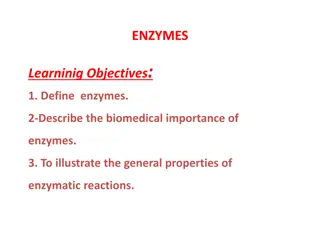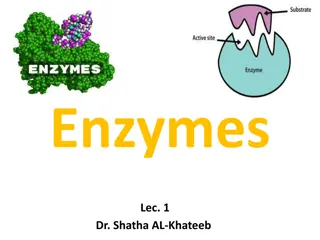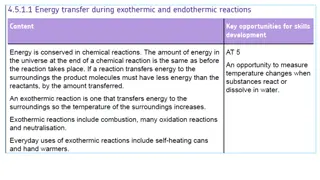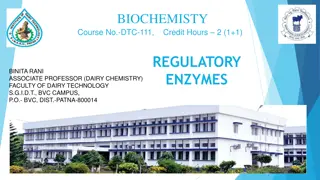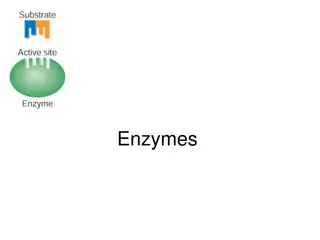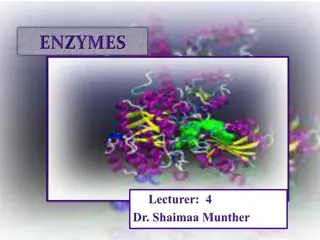Enzymes in Biological Reactions: Understanding Activation Energy
Enzymes, as biological catalysts, play a crucial role in regulating biological processes by lowering the activation energy required for chemical reactions in cells. The addition of enzymes changes the overall energy dynamics of reactions, impacting the rate at which products are formed. This interactive slide show delves into the structure and function of enzymes, emphasizing their significance in modulating the speed of biological reactions.
Download Presentation

Please find below an Image/Link to download the presentation.
The content on the website is provided AS IS for your information and personal use only. It may not be sold, licensed, or shared on other websites without obtaining consent from the author.If you encounter any issues during the download, it is possible that the publisher has removed the file from their server.
You are allowed to download the files provided on this website for personal or commercial use, subject to the condition that they are used lawfully. All files are the property of their respective owners.
The content on the website is provided AS IS for your information and personal use only. It may not be sold, licensed, or shared on other websites without obtaining consent from the author.
E N D
Presentation Transcript
ENZYME GRAPH OPENER Slide show by Kelly Riedell/Brookings Biology LEARNING OBJECTIVE ENE-1.E Explain how enzymes affect the rate of biological reactions. ESSENTIAL KNOWLEDGE ENE-1.E.1 The structure and function of enzymes contribute to the regulation of biological processes a. Enzymes are biological catalysts that facilitate chemical reactions in cells by lowering the activation energy SP 2.A Describe characteristics of a biological concept, process, or model represented visually.
Image from: https://3.bp.blogspot.com/-ofT67cVS3gg/UOaYQS1H__I/AAAAAAAAAY0/8g-JLiA1xrQ/s1600/Test+3+Q+64.jpg Is this a positive delta G or negative delta G reaction? The activation energy required by this reaction without enzyme added is labeled _____ The activation energy required by this reaction with enzyme added is _____ How does adding enzyme change the energy of the products?
Image from: https://3.bp.blogspot.com/-ofT67cVS3gg/UOaYQS1H__I/AAAAAAAAAY0/8g-JLiA1xrQ/s1600/Test+3+Q+64.jpg Is this a positive delta G or negative delta G reaction? The activation energy required by this reaction without enzyme added is labeled _____ The activation energy required by this reaction with enzyme added is _____ How does adding enzyme change the energy of the products?
Image from: https://3.bp.blogspot.com/-ofT67cVS3gg/UOaYQS1H__I/AAAAAAAAAY0/8g-JLiA1xrQ/s1600/Test+3+Q+64.jpg Is this a positive delta G or negative delta G reaction? The activation energy required by this reaction without enzyme added is labeled _____ The activation energy required by this reaction with enzyme added is _____ How does adding enzyme change the energy of the products?
Image from: https://3.bp.blogspot.com/-ofT67cVS3gg/UOaYQS1H__I/AAAAAAAAAY0/8g-JLiA1xrQ/s1600/Test+3+Q+64.jpg Is this a positive delta G or negative delta G reaction? The activation energy required by this reaction without enzyme added is labeled _____ The activation energy required by this reaction with enzyme added is _____ How does adding enzyme change the energy of the products?
Image from: https://3.bp.blogspot.com/-ofT67cVS3gg/UOaYQS1H__I/AAAAAAAAAY0/8g-JLiA1xrQ/s1600/Test+3+Q+64.jpg Is this a positive delta G or negative delta G reaction? The activation energy required by this reaction without enzyme added is labeled _____ The activation energy required by this reaction with enzyme added is _____ How does adding enzyme change the energy of the products?
Image from: https://3.bp.blogspot.com/-ofT67cVS3gg/UOaYQS1H__I/AAAAAAAAAY0/8g-JLiA1xrQ/s1600/Test+3+Q+64.jpg Is this a positive delta G or negative delta G reaction? The activation energy required by this reaction without enzyme added is labeled _____ The activation energy required by this reaction with enzyme added is _____ How does adding enzyme change the energy of the products?




